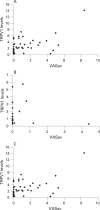Increased capsaicin receptor TRPV1-expressing sensory fibres in irritable bowel syndrome and their correlation with abdominal pain
- PMID: 18252749
- PMCID: PMC2564830
- DOI: 10.1136/gut.2007.138982
Increased capsaicin receptor TRPV1-expressing sensory fibres in irritable bowel syndrome and their correlation with abdominal pain
Abstract
Objective: The capsaicin receptor TRPV1 (transient receptor potential vanilloid type-1) may play an important role in visceral pain and hypersensitivity states. In irritable bowel syndrome (IBS), abdominal pain is a common and distressing symptom where the pathophysiology is still not clearly defined. TRPV1-immunoreactive nerve fibres were investigated in colonic biopsies from patients with IBS, and this was related to abdominal pain.
Methods: Rectosigmoid biopsies were collected from 23 IBS patients fulfilling Rome II criteria, and from 22 controls. Abdominal pain scores were recorded using a validated questionnaire. TRPV1-, substance P- and neuronal marker protein gene product (PGP) 9.5-expressing nerve fibres, mast cells (c-kit) and lymphocytes (CD3 and CD4) were quantified, following immunohistochemistry with specific antibodies. The biopsy findings were related to the abdominal pain scores.
Results: A significant 3.5-fold increase in median numbers of TRPV1-immunoreactive fibres was found in biopsies from IBS patients compared with controls (p<0.0001). Substance P-immunoreactive fibres (p = 0.01), total nerve fibres (PGP9.5) (p = 0.002), mast cells (c-kit) (p = 0.02) and lymphocytes (CD3) (p = 0.03) were also significantly increased in the IBS group. In multivariate regression analysis, only TRPV1-immuno-reactive fibres (p = 0.005) and mast cells (p = 0.008) were significantly related to the abdominal pain score.
Conclusions: Increased TRPV1 nerve fibres are observed in IBS, together with a low-grade inflammatory response. The increased TRPV1 nerve fibres may contribute to visceral hypersensitivity and pain in IBS, and provide a novel therapeutic target.
Figures




Comment in
-
TRPV1: a new target for treatment of visceral pain in IBS?Gut. 2008 Jul;57(7):882-4. doi: 10.1136/gut.2008.149724. Gut. 2008. PMID: 18559382 Free PMC article. Review. No abstract available.
-
TRPV1-expressing sensory fibres and IBS: links with immune function.Gut. 2009 Mar;58(3):465-6. doi: 10.1136/gut.2008.161760. Gut. 2009. PMID: 19211857 No abstract available.
References
-
- Talley NJ, Zinsmeister AR, Van Dyke C, et al. Epidemiology of colonic symptoms and the irritable bowel syndrome. Gastroenterology 1991;101:927–34 - PubMed
-
- Heaton KW, O’Donnell LJ, Braddon FE, et al. Symptoms of irritable bowel syndrome in a British urban community: consulters and nonconsulters. Gastroenterology 1992;102:1962–7 - PubMed
-
- Whitehead WE, Burnett CK, Cook EW, 3rd, et al. Impact of irritable bowel syndrome on quality of life. Dig Dis Sci 1996;41:2248–53 - PubMed
-
- Sandler RS, Drossman DA, Nathan HP, et al. Symptom complaints and health care seeking behavior in subjects with bowel dysfunction. Gastroenterology 1984;87:314–8 - PubMed
Publication types
MeSH terms
Substances
LinkOut - more resources
Full Text Sources
Other Literature Sources
Medical
Research Materials
Miscellaneous
